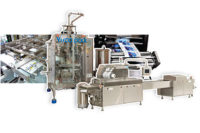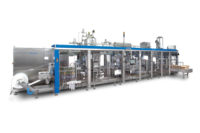Machinery Technology: Form-fill-seal
Form fill seal machines satisfy the need for speed
Innovative bagging systems achieve high speeds without compromising quality or cost. by Alf Taylor, co-founder and chief executive officer, tna

With triple rotary jaws and former changes to facilitate the bagger’s high speeds, the tna robag® range of VFFS machines ensure seal integrity to prevent burst packages and reduce waste.



When selecting vertical form, fill and seal (VFFS) equipment, manufacturers have a seemingly never-ending list of criteria. It has to operate at a low reject rate; it must minimize any waste – both from a product and packaging material point of view, and it should also offer reduced product changeover time with increased speed and weight accuracy and maintain exceptional reliability while being cost-effective to run.
Many manufacturers also demand that their VFFS baggers play a fundamental role in optimizing the efficiency of their production line. VFFS machines have been used across the food industry for over fifty years to bag a wide variety of products quickly and easily. Increasing the operating speed of a bagger and its throughput is one way to improve the overall efficiency of a packaging system. Continued innovation in this area has led to the development of VFFS machines capable of bagging speeds between 120 and 180 bags per minute.
However, whilst operating at high speeds, it is important that product quality is not compromised and unnecessary costs are not incurred. Faster throughputs should have no impact on product quality or cause increased breakage or waste during packaging. VFFS baggers can deliver maximum speeds and efficiency while continuing to maintain key product integrity and overall value.
Uncompromising quality
The key factor to consider here is that although some baggers can operate at unprecedented speeds, this is only effective if manufacturers can maintain low waste, deliver the required product quality and high overall equipment effectiveness (OEE). Achieving these core aims can result in a reduction in labor costs, which in most cases can be the largest portion of a product’s cost. It can also reduce the number of machines required to give the same production output.
The primary obstacle to achieving high packaging speeds is maintaining low reject rates by minimizing product damage and optimizing product transfer. To ensure quality is upheld, it is vital that there is a compact charge of product from the weigher to the jaws of the packaging system. Any interference between these two points can cause product string out. This, in turn, causes waste and product breakage, particularly with more fragile products like potato chips, where the product sizing will vary.
Packaging innovation benefits
Many packaging equipment manufacturers are looking at new and alternative technologies to support quick and consistent transfer through the packaging system. These include the addition of mechanisms between the scale and bagmakers to try to compact the product prior to the forming tube with more moving parts.
These system innovations are not without downsides. Firstly, incorporating extra mechanisms increases the overall height of the packaging system, which can be an issue in plants with low ceiling levels or restricted space. Secondly, it may prevent the inclusion of a metal detector, which is vital due to increasingly stringent traceability requirements in the food industry.
The addition of mechanisms within a VFFS packaging system consequently means the machine now has more moving parts. This has a knock-on effect in terms of product damage and waste, cleaning requirements, increased changeover times, system reliability and the need for replacement spare parts and additional maintenance in the future.
To avoid these issues, food manufacturers employ systems that use as few moving parts as possible and reduce the need for setting up additional equipment. There are VFFS packaging systems that use gravity to transfer the product from the weigher, through the metal detector and into the forming tube on the bagmaker. Product interference by the equipment is therefore kept to a minimum, resulting in reduced product damage during the packaging process less waste. Machines with a small number of moving parts are also easier to clean. A simple design ensures the equipment removes non-value items as part of the drive towards LEAN manufacturing, which dramatically reduces spare part requirements and overall cost of ownership.
Avoiding waste
Using machines which offer low film wastage and quick film changeovers also maximizes overall packaging speed. Accurate and controlled film feed systems now form a fundamental part of many leading VFFS machines. These include the capacity to incorporate film systems of varying sizes, plus features quickly and easily join films during product changeovers. By holding film to back plates with vacuum, manufacturers can easily trim and tape the film during changes.
Sensors can be fitted to film feed systems to synchronize a bagging machine with a registration position on the film and to detect that there is sufficient film tension. These can help ensure a more attractive end package and reduce the amount of film that is used in the packing process.
Minimizing downtime
Minimizing periods of downtime for product changeovers, set-up, repairs and cleaning is a further way of maintaining ambitious throughput targets. Every minute that a manufacturing line is stopped results in lost revenue for the manufacturing company. To reduce the disruption, plant managers should look to include free-standing components throughout the processing system which can be easily removed, cleaned or swapped.
The latest VFFS machines support such flexibility. No mechanical adjustments are needed when changing product or film. Plus, digital data settings have been incorporated for rapid product or pack changes. In addition, hygiene has been carefully considered with machines now featuring quick wipedown stainless steel surfaces.
The latest VFFS machines incorporate innovative technology to help food manufacturers optimize their processing lines. Working with equipment suppliers who can provide effective packaging systems and understanding the unique benefits they offer will help these manufacturers achieve their output goals while also ensuring overall quality is maintained.
tna (tnasolutions.com) is a leading global supplier of integrated food packaging solutions with over 6,000 systems installed across more than 120 countries. The company provides a comprehensive range of products including spraying, distribution, seasoning, weighing, packaging, metal detection and verification solutions, plus promotional and cutting equipment.
Looking for a reprint of this article?
From high-res PDFs to custom plaques, order your copy today!








